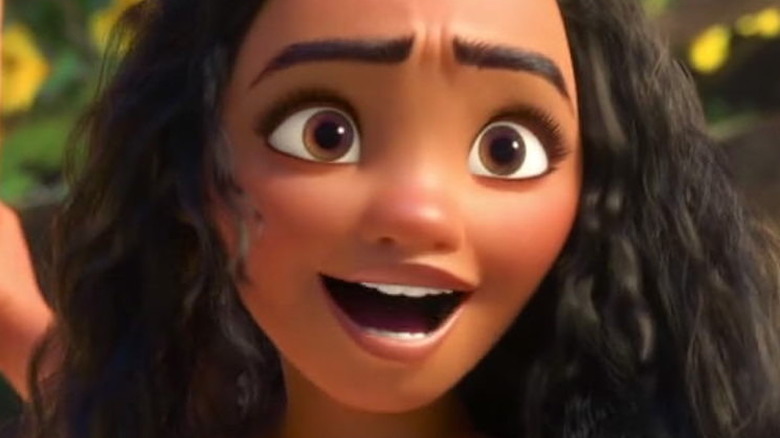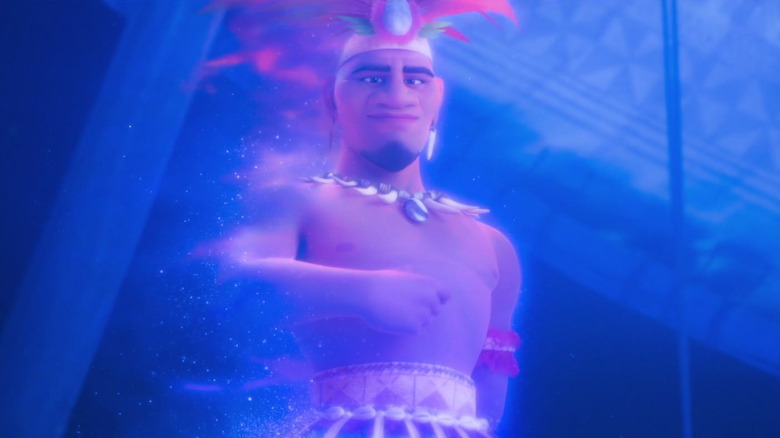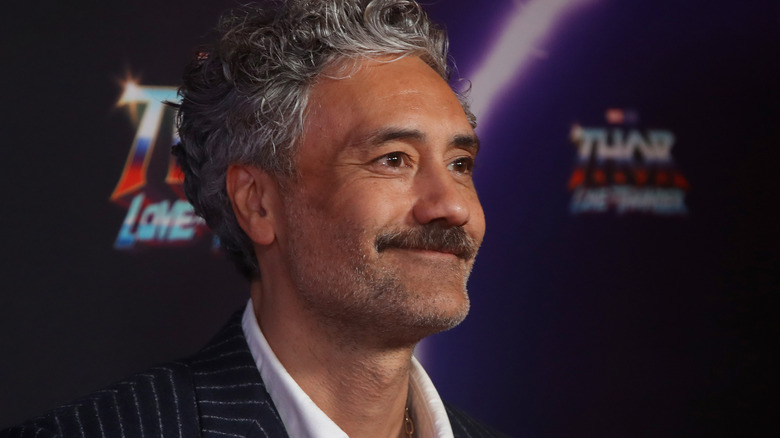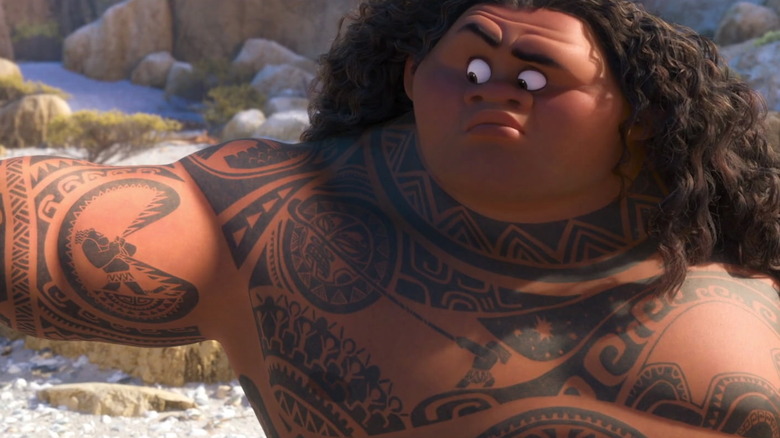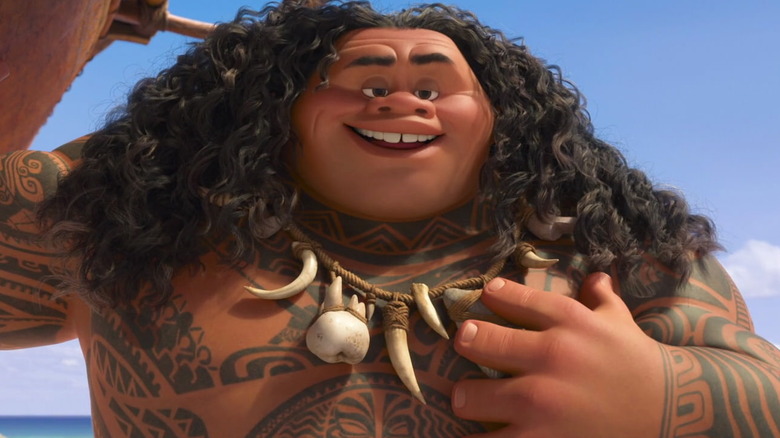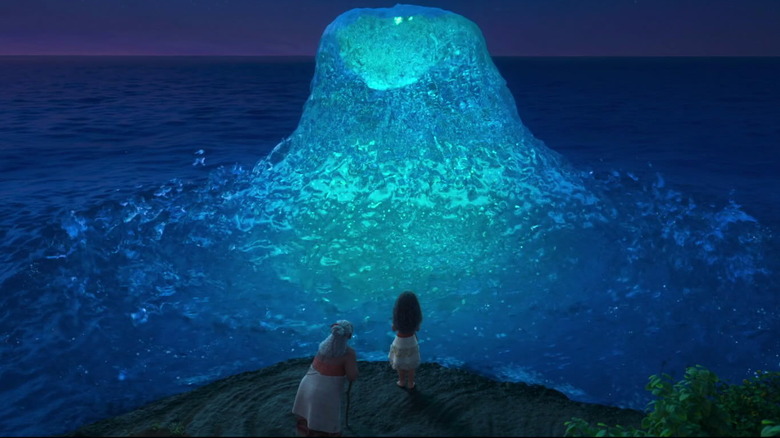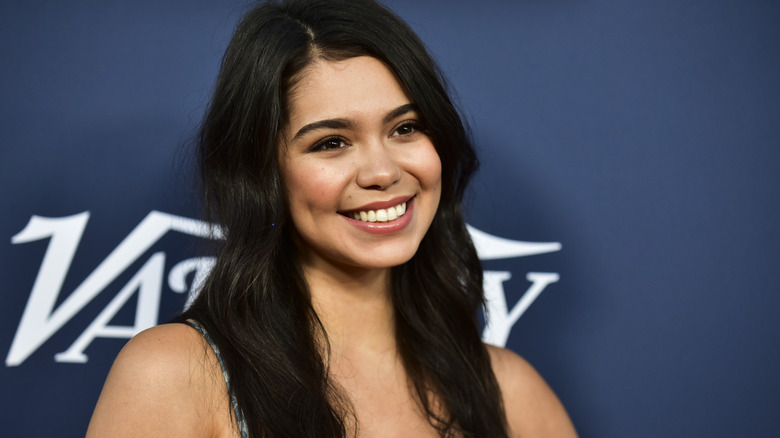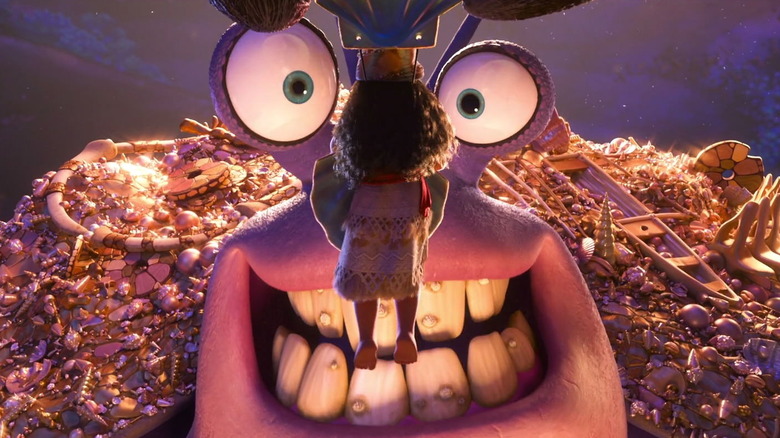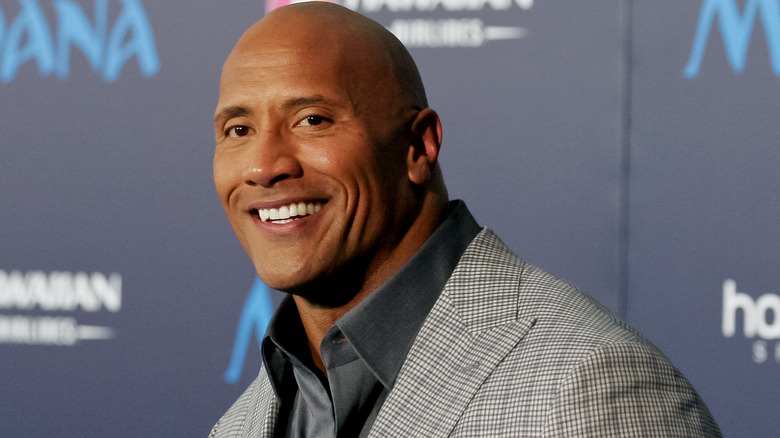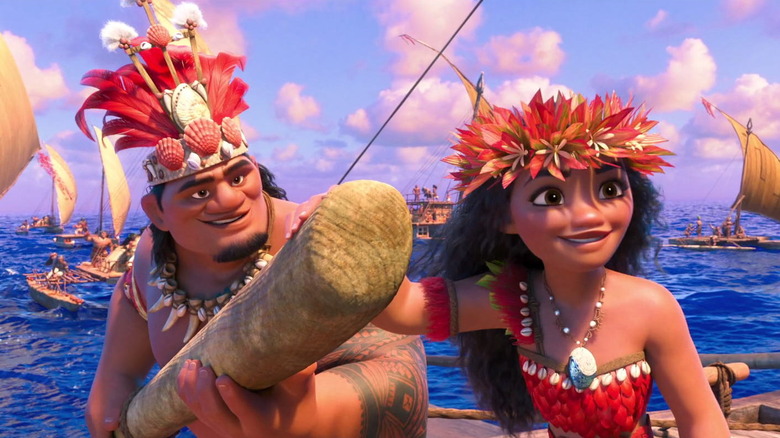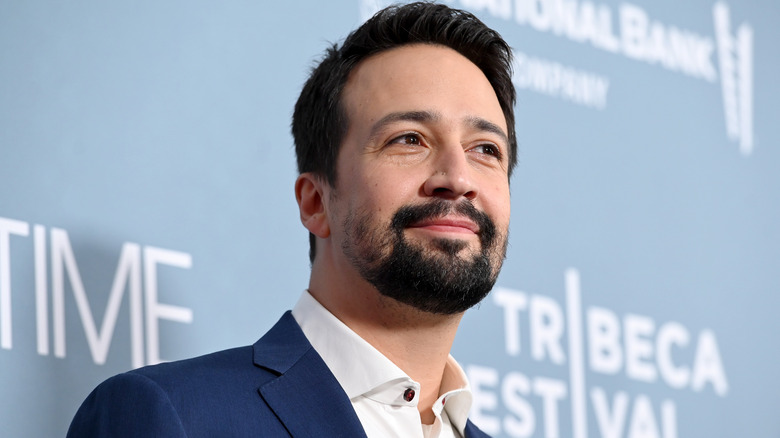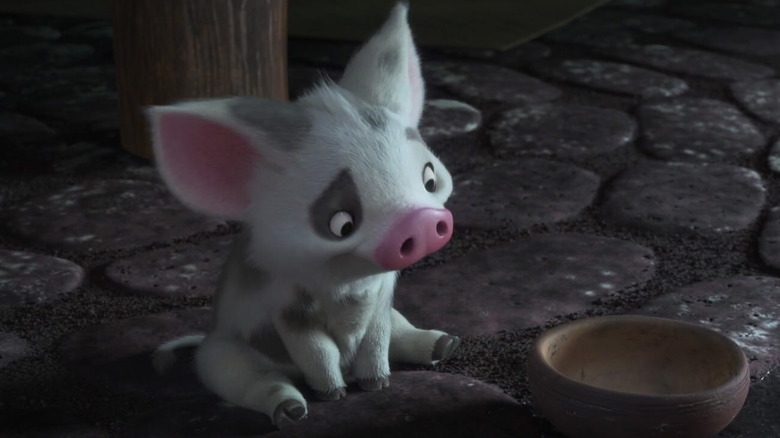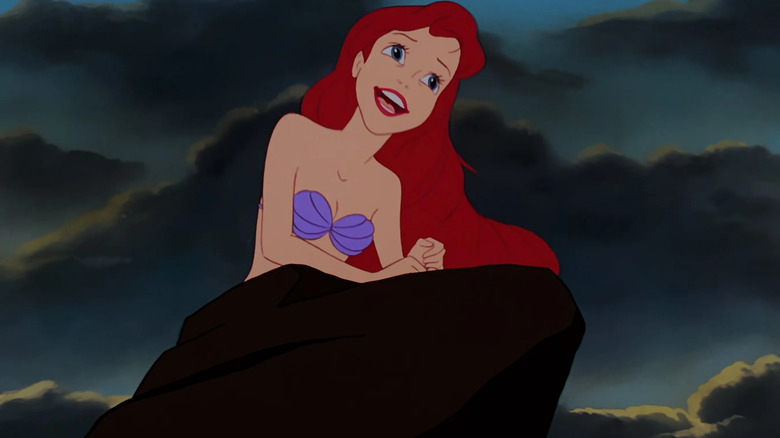The Untold Truth Of Disney's Moana
Disney has produced more beloved animated films than we can even keep track of. One of our absolute favorites, however, is 2016's "Moana" — a bright, buoyant, and lushly animated movie that comes equipped with great characters, a richly portrayed setting, and unbelievably catchy songs. Box office success and overall critical acclaim prove that we're far from alone in our "Moana" love and admiration.
It's time to study the film's depths, from its journey to theaters to its roads not taken to its aftermath and overall significance. The more we dig into the making-of details of "Moana," the greater our appreciation for the film — and the many talented people behind it — becomes. This kind of movie magic is only enhanced by knowing exactly how its effects were accomplished, so this untold truth won't take away any of the film's luster. Like us, you'll just be left marveling at the talent, art, and enthusiasm that went into making this beloved animated masterpiece.
The Oceanic Trust kept things accurate
Animated Disney films don't have the strongest reputation when it comes to cultural sensitivity. "Moana," however, avoids a lot of pitfalls in its portrayal of Polynesian culture and mythology, and that's because its directors, John Musker and Ron Clements, brought in the right experts — trained representatives from the actual region. According to Vanity Fair, they combined these "anthropologists, cultural practitioners, historians, linguists, and choreographers from islands including Samoa, Tahiti, Mo'orea, and Fiji" into what they called the "Oceanic Trust."
While no depiction is going to please everyone — The Guardian chronicled how Maui's physique, for example, drew both criticism and defense from Pacific Islanders — the Oceanic Trust did a lot of invaluable work to keep "Moana" in line with the culture it represents and free of any glaring inaccuracies. For example, Vanity Fair recounts how anthropologist Dionne Fonoti pointed out that Moana would consider the coconuts too sacred for her to toss them around in a fit of temper. Insights like this make "Moana" convincing and absorbing rather than infuriating or wince-worthy.
One of the biggest gaffes the Trust prevented involved portraying Moana's voyager ancestors from appearing in too-formal headdresses and face paint while at sea, with Clements explaining, "It's like wearing tuxedos. You're in the middle of the ocean, and you're wearing tuxedos." It was the kind of detail that would have made anyone familiar with the culture erupt into laughter in the theater, and it's thankfully nowhere near the finished product.
Taika Waititi's vision for Moana
As much as we love the version of "Moana" we have, we wish we could sneak into a parallel universe for a while and see what the great Taika Waititi would've done with the material.
The Waititi-penned first draft of the screenplay worked off an earlier outline from Disney, one where Moana had six brothers and a more outdated plotline about proving she could be just as good as the boys. As director Ron Clements told Moviefone, that was maybe less innovative as a central idea, but he still credited Waititi's sharp handling of the material with making it very interesting.
Waititi's script also featured his distinctive sensibility and what producer Osnat Shurer described as a "a spirit of very specific Pacific Island humor." While Waititi once joked that Disney's approach to his script cut out everything but the scene heading "EXT: OCEAN – DAY," Shurer has insisted that even if most of Waititi's words were lost in the revision and redrafting process, his comedy was a crucial inspiration that "gave [them] permission to continue down that road because he's from that culture, and he taught us how to keep humor in the movie."
In the end, though, Waititi says his version would have leaned even more on the comedy — and it would have been more irreverent. "I know the danger is they've got to be respectful, but Pacific islanders and Polynesians have some of the least respectful humor on the planet," he told The Guardian.
The return of hand-drawn animation
"Moana" touches upon the importance of tradition, so it's only appropriate that the movie itself shows its appreciation for its animated heritage by incorporating some crucial bits of old-school, hand-drawn animation. Directors Ron Clements and John Musker had the perfect way to incorporate 2D animation too: Maui's tattoos ... and one tattoo in particular.
"Somewhere in the process, [Mini-Maui] started to emerge, almost as a Jiminy Cricket alter ego; the tattoo can't speak, but he can communicate with Maui," John Musker told The Hollywood Reporter. The tiny tattooed Maui could prod him to do the right thing because, after all, Mini-Maui is who Maui really wants to be and how he really wants to see himself — grand and heroic, as well as funny.
The interaction between the two really shows off the skill and creativity behind the scenes. Animator Eric Goldberg explained some of the complexities of this to CBR, describing all the work that went into "[Maui] flinching when Mini-Maui pokes him in the belly, or sending Mini-Maui stumbling when the demigod flexes his muscles." Mapping this 2D animation onto a changing 3D surface was tricky because as Maui's CG body moves around, they had to make sure the hand-drawn animation didn't get altered or elongated. The ultimate seamlessness of Maui's moving tattoos is the result of an innovative collaboration that represents the best of the old and the new.
How Maui got his looks (and his locks)
According to The Guardian, Maui's bigger build sparked controversy when the first pictures of him were released, with some commenters accusing Disney of playing into modern Polynesian stereotypes that didn't have anything to do with how Maui's actual culture perceives him.
What most of the internet didn't know was that when it came to Maui's appearance, the filmmakers had already dodged a bullet thanks to the cultural consultants of the film's Oceanic Trust. In his original design, Maui was bald — and this was a big problem. Hinano Murphy, one representative of the Trust, told Vanity Fair that his immediate reaction to the proposed Maui was, "We have to put more hair on Maui's head because it's very important. The mana is in the hair, the power of the demigod. It looked just like he was naked." Looking at Maui now, it's hard to imagine him without his hair. It feels as iconic as his tattoos.
As much as Maui was vetted by committee, he also has a very specific and individual ancestry. Dwayne Johnson revealed on Twitter that his grandfather, Samoan High Chief Peter Maivia, was one of the animators' inspirations. Considering Maivia was a wrestling superstar, it's no wonder that Johnson seems to have been fine with his demigod-of-action character's physique. He knows exactly how powerful men like Maui can be.
Oceanic waves and lustrous hair
The world of "Moana" is colorful, immersive, and beautiful to look at, and it represents not only an immense amount of work for its animators but also an immense amount of technical innovation. This is because "Moana" features a lot of flowing, unpredictably mobile elements like loose hair, a vividly realized ocean, and even a lava monster.
So how was this accomplished? Part of the answer is adopting some old-school, hand-drawn animation techniques. Director John Musker told IndieWire, "The greatest thing of hand-drawn is the expressiveness, and the animators were happy to push it with tricks to break the CG and make it bend more." But the human element could only do so much. These animations still had to work with the film's overall look, and that meant figuring out new technological solutions.
As a result, two new bits of design tech were invented – APIC (or Splash), for water, and Quicksilver, for hair. APIC was especially important as Moana's entire journey involves the ocean, including her interactions with water at its most magical and affectionate. Quicksilver was simple in comparison, but IndieWire confirms that the lava animation was the trickiest part of all. Musker summed it all up by saying they basically had to fool the computer in order to avoid glitches around Te Kā's appearance.
To the viewer, of course, it all looks natural and effortless.
Special dubs
While Disney's international reach means its films have a long and rich history of being dubbed into other languages, "Moana" still marks a first in that regard, with Disney authorizing dubs in several different Polynesian languages to ensure the cultures represented in the film have access to it in their own languages.
In 2016, "Moana" hit a milestone when it was dubbed into Tahitian, which Disney described as "a first for a major motion picture." Two years later, thanks to the efforts of the University of Hawaiʻi, it also became the first Disney picture to be re-released in ʻōlelo Hawaiʻi (also known as Hawaiian). Most of the voice actors for the dub were new to the project, but star Auli'i Cravalho reprised her role as Moana. Keeping the lead performer is quite a coup for a dub, and we're delighted Cravalho returned.
The dub into te reo Māori (the endangered language of the Maori people of New Zealand), as The New York Times points out, was also a passion project. It came into being because of producers Taika and Tweedie Waititi, with the famed director saying (per Stuff), "It ... encourages our youth to continue with their love and learning of the language, letting them know their culture has a place in the world." Several of the original cast members — including Rachel House and Jemaine Clement — also returned for this version, which speaks to the personal significance it held for them.
Personal songs, regional songs
One of the best parts of the "Moana" soundtrack is how distinctive it is, both culturally and personally. And Lin-Manuel Miranda — who co-wrote the songs with Mark Mancina and Opetaia Foa'i — emphasized this in an interview with People. Most of the songs, Miranda said, are heavily shaped by the Samoan Foa'i and influenced by all the research that had gone into the film as a whole. They aren't generic Disney pieces. As he put it, "Opetaia led the charge, and I think we took the lead from him in terms of the rhythms and tempos and harmonies that really make it sound like it's from that part of the world."
Even the "Moana" songs that don't necessarily adhere to the Foa'i-inspired style still tend to have flair and personality. "Shiny," for example, is fueled by Miranda's enthusiasm for Jemaine Clement and admiration for the recently deceased David Bowie: "The world had already been mourning Bowie, I'd been listening to Bowie on a loop. I was like, well I'm writing a glam rock tune for this crab, this jewel-encrusted crab." That's not an inspiration you come across very often, and it shows in the irresistible final results.
"How Far I'll Go" is probably an exception because, as People notes, it's Moana's "angsty, 'I'm independent' song," which is a Disney staple. After all, being a dramatic teenager prone to sweeping statements is almost universal. For this one, Miranda sought inspiration for the lyrics by returning to his own childhood bedroom, where he could soak up his own past teen angst.
Dwayne Johnson's secret identity
Most "Moana" viewers know that the self-aggrandizing, secretly vulnerable demigod Maui is voiced by the great Dwayne Johnson. In fact, there may only be one "Moana" super-fan who doesn't realize — and, in fact, adamantly denies — Dwayne Johnson's role in creating the character.
That lone hold-out is Johnson's daughter, Tiana, whose inability to reconcile her dad with her beloved movie character became a little bit of an internet sensation after Johnson talked about it on Instagram. Johnson elaborated, "She always says, 'Daddy, you're not Maui, you're the Rock.'" If 4-year-old Tiana's firm stance on this wasn't adorable enough on its own, the fact that Johnson revealed it in a post about him having a tea party with her and her stuffed rabbit sealed the deal.
Sleuths over at ComicBook dug up other instances of Johnson mentioning Tiana being unaware of her dad's connection to Maui. Admittedly, when she was just a toddler who loved listening to him sing "You're Welcome," it's less surprising that she didn't realize his secret identity. Now, though, it's become an ongoing joke, one that has some surprising twists. Back in 2021, when Tiana was 3, she appeared to go through a brief phase of understanding her dad's voice acting — whereupon, Johnson reported, she mostly just wanted to know if this meant he knew Aquaman. A year later, Tiana's doubts clearly resurfaced. It takes time to process such a major revelation.
Illuminating the history of wayfinding
When Moana discovers her ancestors' seafaring history, it shows her that being drawn to the ocean doesn't make her an oddity: She's part of a longstanding tradition. The sailing and navigation techniques Maui subsequently introduces her to are probably new to the audience as well, but they're actually an established part of Polynesian history. By sharing it with international viewers, "Moana" enriches the general understanding of Polynesian history.
The real-life people who inspired Moana's creation traversed an immense amount of territory in the South Pacific, discovering and inhabiting new islands across the South Seas. Of course, these Polynesian explorers could only navigate these waters and find new islands if they had a strong navigational system. And as it turns out, they did, and it's the wayfinding practice Maui teaches Moana.
According to Hawaiian Voyaging Traditions, wayfinders must retain a huge quantity of information about the behavior and positioning of stars, waves, wind, and birds. The navigation process is a continuous one. As the site explains, "You have to constantly remember your speed, your direction, and time. You don't have a speedometer. You don't have a compass. You don't have a watch. It all has to be done in your head." It's an impressive and intimidating skill, and Moana's embrace of it tells us how capable she is — and what a remarkable history inspired her.
Lin-Manuel Miranda's collaboration with Disney
When Lin-Manuel Miranda was co-writing the songs for "Moana," he was, as he told Vulture, smack in the middle of American's "Hamilton" fever — still dealing with intense Broadway success and sudden international fame and still performing as Alexander Hamilton on-stage. "'Moana' was my oasis during 'Hamilton,'" he said. "Anytime I needed a break as the whole phenomenon was unfolding, I could go sail the seas with Moana."
The one-two punch of "Hamilton" and "Moana" led Miranda to a whole new level of his career. After "Moana," he continued to work with Disney, but the work no longer represented a peaceful oasis, and the truth is that he didn't want it to. Speaking with Cinemablend, Miranda shared the one problem with his first Disney songwriting job: "I had an amazing experience working on 'Moana,' but I was the last guy hired. I was sort of jumping on a train in motion." As much as he valued the experience, he had one question at the end of it: "'Can I just be there for the beginning of the next one?'" He got his wish — and greater artistic participation — with the hit "Encanto."
Miranda continues to work with Disney on multiple projects — including contributing new songs for the live-action remake of "The Little Mermaid" — but "Moana" will always mark the start of their ongoing (and immensely popular) collaboration.
What happened to the pig?
If you immediately fell for Moana's adorable pet pig, Pua, then you're not alone — and you're also not alone in being disappointed at how Pua is sidelined for most of the film. We're not used to seeing animated Disney's animal sidekicks left out of the main adventure. When the film ditches Pua back on Motunui and instead sticks Moana with the endearingly dumb rooster, Heihei, we do a double-take. It almost feels like a twist. Fans were so thrown by it that Medium even ran a cheeky article suggesting various Pua-related conspiracy theories to explain the pig's absence.
It's not only a subversion of our expectations — it even subverted the expectations of the people making the film. Producer Osnat Shurer told EW that Pua was originally slated as Moana's traveling companion. While Disney movie convention would've meant bringing Pua along, Shurer was actually following an older storytelling template: "The issue was that in a classic hero's journey, the hero leaves all comforts behind. And so we made the difficult decision to leave poor Pua at home."
It's a good reason that serves the narrative, but as Shurer himself concedes, "It wasn't a very popular decision around the office; there was almost a petition through the studio to [have Moana] take the pig." ScreenRant eventually revealed that even co-directors John Musker and Ron Clements were ambivalent about it.
From Ariel to Moana
"Moana" directors John Musker and Ron Clements are longtime creative partners, and "Moana" isn't even the first ocean-themed Disney film they worked on together. They also shared directing and writing credits on 1989's iconic "The Little Mermaid." Unsurprisingly, "Moana" sneaks in a few nods to its older, hand-drawn sibling.
One of them is obvious, at least if you sit through the credits. The movie's stinger scene reveals that giant crab Tamatoa still hasn't managed to flip himself over onto his feet — and he suspects that's because he's the less-beloved of the two main Disney crabs: "If my name was Sebastian and I had a cool Jamaican accent, you'd totally help me!" Probably ... but then, Sebastian wasn't trying to eat the movie's protagonists. That point leads us into the second big "Little Mermaid" nod, with Tamatoa's anthem "Shiny." As Lin-Manuel Miranda explained, "I call [it] Sebastian's Revenge: a Disney crab singing about eating humans."
Fans have had a lot of fun pointing out other ways the two movies are connected, especially with "Moana" acting as "The Little Mermaid" in reverse, and we have to agree that there's definitely a family resemblance.
